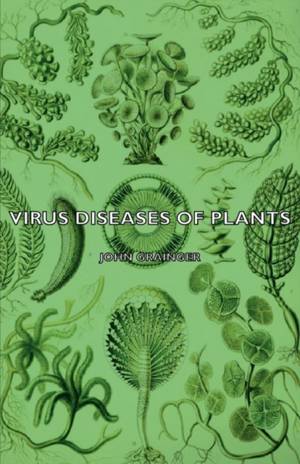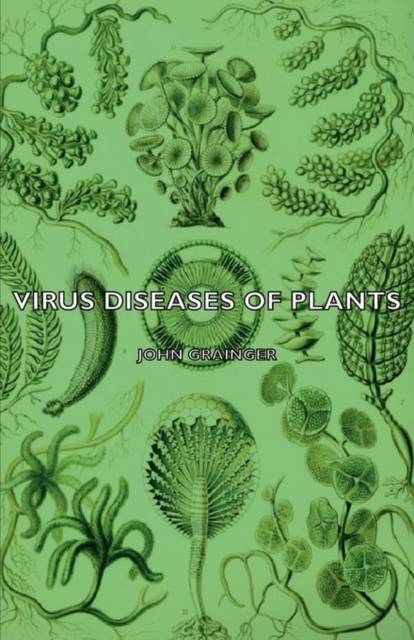
- Retrait gratuit dans votre magasin Club
- 7.000.000 titres dans notre catalogue
- Payer en toute sécurité
- Toujours un magasin près de chez vous
- Retrait gratuit dans votre magasin Club
- 7.000.0000 titres dans notre catalogue
- Payer en toute sécurité
- Toujours un magasin près de chez vous
Description
VIRUS DISEASES OF PLANTS VIRUS DISEASES OF PLANTS BY JOHN GRAINGER PH. D., B. Sc. OXFORD UNIVERSITY PRESS LONDON HUMPHREY MILFORD 1934 PREFACE THE need for a small book upon the subject of Plant Virus Diseases appeared during my teaching work at Leeds University and in the County of Yorkshire. The study of this subject is, indeed, developing rapidly, but it seemed that this was not sufficient justification for with holding a simple text-book from the student of Mycology or Plant Pathology. A comprehensive volume would be inappropriate, as yet, and would have a limited use. The aim of this book has therefore been to introduce the student to the phenorrfcria associated with Virus Diseases, rather than to provide him with descriptions of all known viroses it is typical rather than complete. Many pitfalls aw r ait the new worker on Virus Diseases, so it was decided to include descriptions of the various items of technique in common use. The list of references at the end of the volume will provide an introduction to the very extensive literature on the subject of Plant Viruses. In its compilation, accessibility and comprehensiveness o the papers quoted have been constantly in mind. The references cited in the text follow the general plan of the book, being representative, not exhaustive. It is with great pleasure that I acknowledge my in debtedness to many persons to my wife, for much con structive criticism and help, and to Dr. J. Henderson Smith, of Rothamsted, who criticized the manuscript in its early stages. Dr. J. Johnson, of Wisconsin University, U. S. A., has helped in ways too numerous to mention, and Prof. J. H. Priestley, of Leeds University, introduced me to the study of Virus Diseases of Plants, and helped consider ably in its prosecution. Many workers in Ireland, Holland, America, Germany, and our own country have given written and verbal communication of their results. The Oxford University Press has throughout been most cour teous and helpful. J-G - June, 1933. J CONTENTS . INTRODUCTORY. Historical i II. THE RELATION OF A VIRUS TO ITS HOST PLANT 4 Symptoms of Mosaic Diseases. Symptoms of Yellows Diseases. Miscellaneous Symptoms. Symptom Complexes the Potato Virus Group. Host Range of Virus Diseases. Carriers. Increase and De crease of Virulence. Resistant Varieties. Immunity. Recovery. The Masking of Symptoms. The Effects of Shading. Seed Trans mission. Pollen Transmission. Soil Transmission. Virus Diseases and Vegetative Propagation. Histology and Cytology. Local Lesions. Necrosis. The Spread of Virus in its Host. The Concen tration of Virus in its Host. Physiological Effects. Developmental Anatomy. Organisms associated with Virus Diseases. . PROPERTIES OF THE VIRUS EXTRACT . . 24 Studies on the Effect of Heat. Concentration of the Virus Extract. Inactivation by Disinfectants, c. Attenuation by Oxygen. Ultra-Violet and Dark-Ground Photography. Ageing of the Virus Extract. Inactivation by High Pressure and Pulverisation. Filtra tion and Size of Virus Particles. The Participate Nature of the Virus. Purification of the Virus Extract. Chemical Nature of the Virus. Attempted Cultivation of the Virus in vitro. The Electrical Charge of Virus Particles. IV. THE RELATION OF INSECTS TO VIRUS DISEASES 35 General Characters of Insect Transmission. Technique of Insect Transmission. Insect Cages. Transference of Insects. The In cubation Period of the Virus on the Insect. The Duration of Virus bearing by the Insect. The Preparation of Microscope Slides of Insects Feeding on Plant Tissue. An Insect Test for the Filter passing Ability of Some Viruses. Some Virus Diseases and their Insect Vectors. V. ECONOMIC EFFECTS AND MEASURES OF CONTROL . . . . . .44 Damage caused by Virus Diseases. Potato Viruses. Rogueing. The Use of Resistant Varieties. The Use of Carrier Varieties. The Use of Immune Varieties. Vegetatively Propagated Stocks should be free from Disease. Indexing. The Use of Seed Propagation. The Sterilization of Soil...
Spécifications
Parties prenantes
- Auteur(s) :
- Editeur:
Contenu
- Nombre de pages :
- 124
- Langue:
- Anglais
Caractéristiques
- EAN:
- 9781406774832
- Date de parution :
- 15-03-07
- Format:
- Livre broché
- Format numérique:
- Trade paperback (VS)
- Dimensions :
- 140 mm x 216 mm
- Poids :
- 167 g

Les avis
Nous publions uniquement les avis qui respectent les conditions requises. Consultez nos conditions pour les avis.






